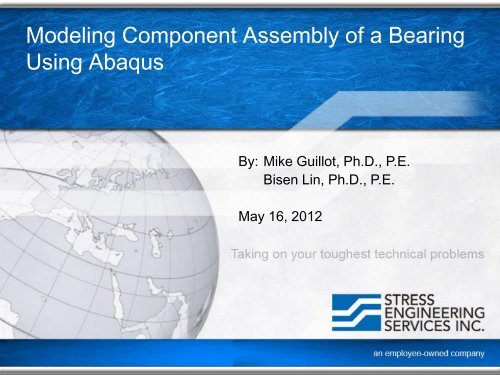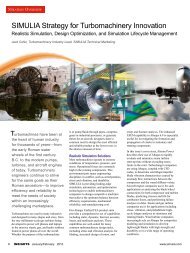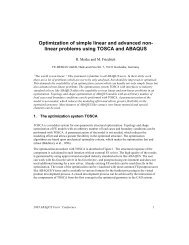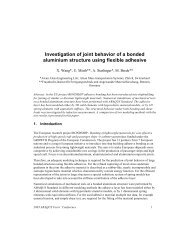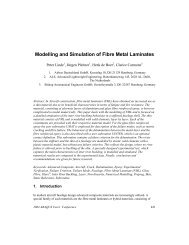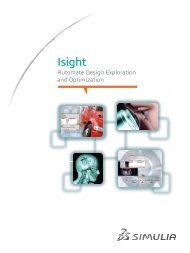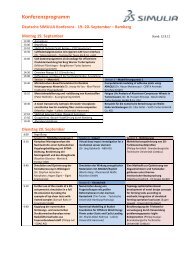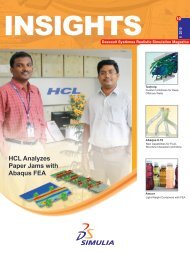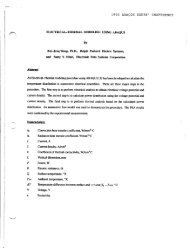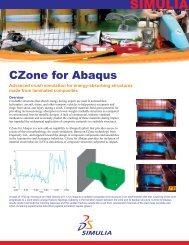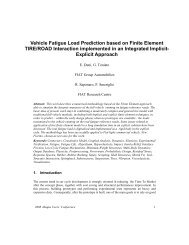Modeling Component Assembly of a Bearing Using Abaqus - SIMULIA
Modeling Component Assembly of a Bearing Using Abaqus - SIMULIA
Modeling Component Assembly of a Bearing Using Abaqus - SIMULIA
You also want an ePaper? Increase the reach of your titles
YUMPU automatically turns print PDFs into web optimized ePapers that Google loves.
<strong>Modeling</strong> <strong>Component</strong> <strong>Assembly</strong> <strong>of</strong> a <strong>Bearing</strong><br />
<strong>Using</strong> <strong>Abaqus</strong><br />
By: Mike Guillot, Ph.D., P.E.<br />
Bisen Lin, Ph.D., P.E.<br />
May 16, 2012
2<br />
Problem<br />
A bearing leaked cooling fluid into a process<br />
causing a major disruption at a chemical plant.<br />
An investigation indicated a seal weld had failed<br />
due to fatigue. The same bearing is on<br />
numerous units and has been in service many<br />
years with no issues. The client wanted to<br />
evaluate the stresses in the seal weld due to the<br />
variability in the manufacturing process as well<br />
as operational variations. <strong>Abaqus</strong> was used to<br />
conduct a sensitivity analysis on this complex<br />
bearing assembly.
3<br />
Overview<br />
• <strong>Abaqus</strong> modeling techniques used in present work.<br />
Model change for removal / reactivation <strong>of</strong> elements and contact pair.<br />
Contact interference fit, shrink fit.<br />
• FEA model descriptions:<br />
Model geometry and mesh.<br />
Temperature-dependent material properties.<br />
Constraints and interactions<br />
Loads and boundary conditions<br />
• Model assemble and analysis procedure.<br />
• Analysis results.<br />
• Sensitivity study on the initial interference.<br />
• Comments and closure.
4<br />
<strong>Modeling</strong> Technique (1/2)<br />
• Model Change: Removal / reactivation <strong>of</strong> elements and contact pairs with strain-free<br />
condition.<br />
• <strong>Abaqus</strong> input usage:<br />
Parts (elements) removal:<br />
*Model Change, Type=Element, Removal<br />
Element_Set_Name<br />
Parts (elements) reactivation w/ strain-free:<br />
*Model Change, Type=Element, Add<br />
Element_Set_Name<br />
Contact pair removal:<br />
*Model Change, Type=Contact Pair, Removal<br />
Slave_Surface_Name, Master_Surface_Name<br />
Contact pair reactivation:<br />
*Model Change, Type=Contact Pair, Add<br />
Slave_Surface_Name, Master_Surface_Name
5<br />
<strong>Modeling</strong> Technique (2/2)<br />
• Contact Interference Fit: to similate the sequential assemble <strong>of</strong> the three-layer<br />
bearing.<br />
• <strong>Abaqus</strong> input usage:<br />
Automatic shrink fit in the first analysis step:<br />
*Contact Interference, Shrink<br />
Slave_Surface_Name, Master_Surface_Name<br />
Interference fit in the subsequent steps for resolving initial interference:<br />
*Contact Interference<br />
Slave_Surface_Name, Master_Surface_Name, v<br />
– v: reference allowable interference. This value is applied instantaneously at the start<br />
<strong>of</strong> the step and ramped down to zero linearly over the step by default. It is<br />
recommended that you specify the allowable interference v in a separate step that<br />
there are no other loads applied. Additional loads and/or boundary conditions may<br />
adversely affect the resolution <strong>of</strong> the interference fit and the response to the loading<br />
with partially resolved interferences may be non-physical [1].
6<br />
<strong>Abaqus</strong> FEA model<br />
• An axisymmetric model <strong>of</strong> the bearing assembly<br />
is used.<br />
• <strong>Abaqus</strong> CAE version 6.10-1 is used.<br />
• Linear elastic material and linear geometry are<br />
considered.<br />
• The four-step assembly process <strong>of</strong> the bearing is<br />
performed followed by the coupled temperaturedisplacement<br />
steady-state analysis.
7<br />
Middle Layer<br />
(Cooling<br />
Sleeve)<br />
Axis <strong>of</strong><br />
Rotation<br />
Inner Layer<br />
(<strong>Bearing</strong><br />
Sleeve)<br />
Model Geometry and Mesh<br />
Weld<br />
Weld<br />
Outer Layer<br />
(<strong>Bearing</strong><br />
Housing)<br />
The entire assembly was<br />
modeled as CAX4T, a 4-node<br />
axisymmetric thermally coupled<br />
quadrilateral element, bilinear in<br />
displacement and temperature.
8<br />
Material Properties (1/3)<br />
• <strong>Bearing</strong> housing is made <strong>of</strong> AISI 4140 low alloy<br />
steel.<br />
• Other parts, i.e. cooling sleeve and bearing<br />
sleeve, and welds are made <strong>of</strong> 1026 low carbon<br />
steel.<br />
• Temperature-dependent mechanical and<br />
thermal properties including Young’s modulus,<br />
coefficient <strong>of</strong> thermal expansion, and thermal<br />
conductivity are shown in the next slide.<br />
Poisson’s ratio <strong>of</strong> 0.3 is used.
9<br />
Young's Modulus (psi)<br />
3.00E+07<br />
2.90E+07<br />
2.80E+07<br />
2.70E+07<br />
2.60E+07<br />
2.50E+07<br />
Material Properties (2/3)<br />
0 100 200 300 400 500 600 700<br />
Temperature (F)<br />
1026 Steel<br />
4140 Steel
10<br />
Material Properties (3/3)<br />
Thermal Conductivity (BTU/hr-ft-F)<br />
Coefficient <strong>of</strong> Thermal Expansion (1/F)<br />
40<br />
35<br />
30<br />
25<br />
20<br />
15<br />
10<br />
5<br />
0<br />
8.0E-06<br />
7.6E-06<br />
7.2E-06<br />
6.8E-06<br />
6.4E-06<br />
6.0E-06<br />
Same for both materials<br />
0 100 200 300 400 500 600 700<br />
Temperature (F)<br />
0 100 200 300 400 500 600 700<br />
Temperature (F)<br />
1026 Steel<br />
4140 Steel
11<br />
Int-3<br />
Contact Interactions<br />
Int-1<br />
Int-2<br />
Int-1: Upper contact between cooling sleeve<br />
and bearing housing<br />
Int-2: Lower contact between cooling sleeve<br />
and bearing housing<br />
Int-3: Contact between bearing sleeve and<br />
cooling sleeve
12<br />
Loads and Boundary Conditions<br />
Pressure = 8000 psi<br />
Temperature = 488 F<br />
Insulated 380 F<br />
Insulated<br />
441 F<br />
U2=0<br />
Pressure = 75 psi<br />
Temperature = 437 F<br />
Linear thermal gradient<br />
(380F to 441F)
13<br />
Model Assemble and Analysis Procedure<br />
Step-1. Shrink fit <strong>of</strong> outer layer (bearing housing)<br />
and middle layer (cooling sleeve)<br />
Step-2. Activation <strong>of</strong> the welds at two-end<br />
grooves between cooling sleeve and bearing<br />
housing in strain-free state.<br />
Step-3. Activation <strong>of</strong> the inner layer (bearing<br />
sleeve) in strain-free state.<br />
Step-4. Interference fit <strong>of</strong> bearing sleeve and the<br />
assembly <strong>of</strong> cooling sleeve and bearing housing.<br />
Step-5. Applications <strong>of</strong> loads and thermal<br />
boundary conditions for further stress analysis.
14<br />
Consideration <strong>of</strong> Different Initial Interferences<br />
Case No.<br />
Int-1<br />
(<strong>Bearing</strong> Housing<br />
and Cooling Sleeve,<br />
Upper)<br />
Initial Diametral Interference (inch)<br />
Int-2<br />
(<strong>Bearing</strong> Housing<br />
and Cooling Sleeve,<br />
Lower)<br />
Int-3<br />
(Cooling Sleeve<br />
and <strong>Bearing</strong><br />
Sleeve)<br />
C-1 0.005 0.005 0.002<br />
C-2 0.005 0 0.002<br />
C-3 0.005 0.005 0.005<br />
C-4 0.005 0 0.005
15<br />
Analysis Results <strong>of</strong> Case C-1 (1/3)<br />
• Step-1. Shrink fit cooling sleeve and bearing housing with initial<br />
diametral interference equal to 0.005 inch for both Int-1 and Int-2.<br />
This induces von Mises stress at a level <strong>of</strong> ~10ksi in cooling sleeve.<br />
• Step-2. Activate groove welds with strain-free condition. Stresses in<br />
the welds were verified to be zero.<br />
• Step-3. Activate bearing sleeve with strain-free condition. Stresses<br />
in the bearing sleeve were verified to be zero.<br />
• Step-4. Interference fit bearing sleeve and the assembly <strong>of</strong> cooling<br />
sleeve and bearing housing with initial diametral interference equal<br />
to 0.002 inch for Int-3, and 0.002 inch for Int-3. This induces von<br />
Mises stress at a level <strong>of</strong> ~11ksi in bearing sleeve. Meanwhile, the<br />
stress in cooling sleeve is reduced from ~10ksi to ~8ksi and the<br />
stress in bearing housing is increased to ~3ksi to ~8ksi.<br />
• Step-5. Application <strong>of</strong> Loads. This introduces high stresses at tip<br />
<strong>of</strong> the lower weld as well as at the discrete contacts between<br />
bearing housing (outer layer) and cooling sleeve (middle layer).
16<br />
Analysis Results <strong>of</strong> Case C-1 (2/3)<br />
[ psi ]<br />
von Mises Equivalent Stress Contour<br />
Step-1 Step-2 Step-3 Step-4
17<br />
Analysis Results <strong>of</strong> Case C-1 (3/3)<br />
Temperature and von Mises Equivalent Stress Contours<br />
[ ºF ] [ psi ]<br />
Step- Application <strong>of</strong> Thermal and Mechanical Loads
18<br />
Results <strong>of</strong> Sensitivity Study (1/4)<br />
• Overall, the assembly in C-2 has the best stress distribution; while<br />
the assembly in C-3 has the highest stress regions.<br />
• As can be seen in the next slide for C-1 and C-2, decreasing the<br />
interference at Int-2 (i.e. at lower interface between bearing housing<br />
and cooling sleeve) tends to distribute the stress better and also<br />
reduces stresses in bearing housing and sleeve. This is also<br />
demonstrated by comparing C-3 to C-1.<br />
• As can be seen in the next slide for C-1 and C-3, increasing the<br />
interference at Int-3 (i.e. at interface between cooling sleeve and<br />
bearing sleeve) tends to increase stresses, especially in bearing<br />
housing and cooling sleeve. This can also be observed by<br />
comparing C-4 to C-2.<br />
• Therefore, reducing the initial interferences at Int-2 and Int-3 will<br />
lower the stresses in the assembly including the welds.<br />
• These stress results can then be used in the further structural<br />
integrity and component fatigue life assessments.
19<br />
Results <strong>of</strong> Sensitivity Study (2/4)<br />
[ psi ] [ psi ] [ psi ] [ psi ]<br />
C-1<br />
Int-1=0.005in<br />
Int-2=0.005in<br />
Int-3=0.002in<br />
C-2<br />
Int-1=0.005in<br />
Int-2=0 in<br />
Int-3=0.002in<br />
C-3<br />
Int-1=0.005in<br />
Int-2=0.005in<br />
Int-3=0.005in<br />
C-4<br />
Int-1=0.005in<br />
Int-2=0 in<br />
Int-3=0.005in
20<br />
Results <strong>of</strong> Sensitivity Study (3/4)<br />
[ psi ] [ psi ] [ psi ] [ psi ]<br />
C-1<br />
Int-1=0.005in<br />
Int-2=0.005in<br />
Int-3=0.002in<br />
von Mises equivalent stress at low weld<br />
C-2<br />
Int-1=0.005in<br />
Int-2=0 in<br />
Int-3=0.002in<br />
C-3<br />
Int-1=0.005in<br />
Int-2=0.005in<br />
Int-3=0.005in<br />
C-4<br />
Int-1=0.005in<br />
Int-2=0 in<br />
Int-3=0.005in
21<br />
Results <strong>of</strong> Sensitivity Study (4/4)<br />
[ psi ] [ psi ] [ psi ] [ psi ]<br />
C-1<br />
Int-1=0.005in<br />
Int-2=0.005in<br />
Int-3=0.002in<br />
Max principal stress at low weld<br />
C-2<br />
Int-1=0.005in<br />
Int-2=0 in<br />
Int-3=0.002in<br />
C-3<br />
Int-1=0.005in<br />
Int-2=0.005in<br />
Int-3=0.005in<br />
C-4<br />
Int-1=0.005in<br />
Int-2=0 in<br />
Int-3=0.005in
22<br />
Comments and Closure<br />
• <strong>Modeling</strong> <strong>of</strong> a bearing assembly procedure was<br />
considered in this paper using the special techniques in<br />
<strong>Abaqus</strong>, i.e.<br />
Model change.<br />
Contact interference fit.<br />
• The example demonstrates the high-quality capability <strong>of</strong><br />
<strong>Abaqus</strong> to simulate real world designs.<br />
• Multiple cases in which design parameters, i.e. initial<br />
overclosure values were varied allowed their sensitivity<br />
to be understood.<br />
• The results were then used in the structural integrity and<br />
component fatigue life evaluations <strong>of</strong> the existing<br />
equipment to aid in an improved fatigue resistant design.
23<br />
Contact Information<br />
Mike Guillot, Mike.Guillot@stress.com<br />
Bisen Lin, Bisen.Lin@stress.com<br />
Stress Engineering Services<br />
13800 Westfair East Drive<br />
Houston, Texas 77041<br />
Phone: (281) 955-2900<br />
Fax: (281) 955-2638<br />
www.stress.com


